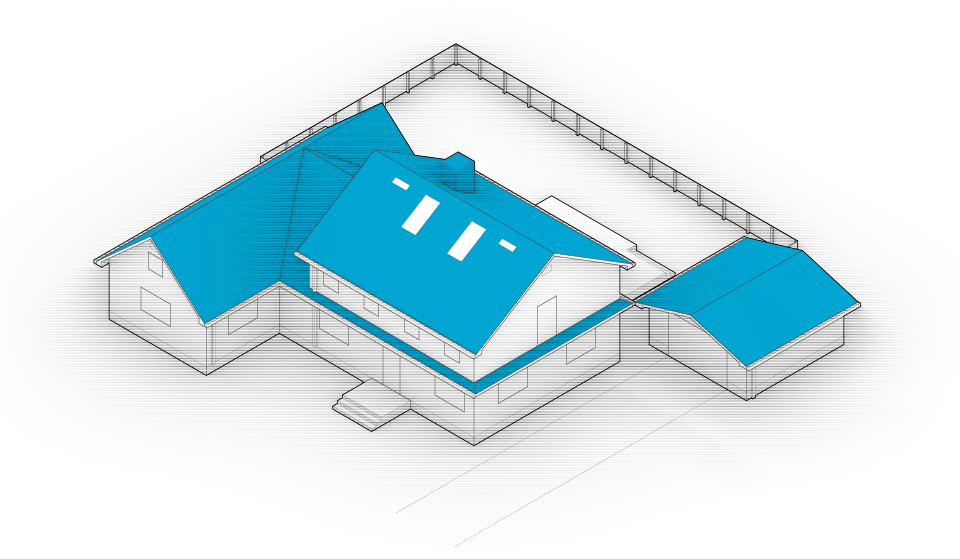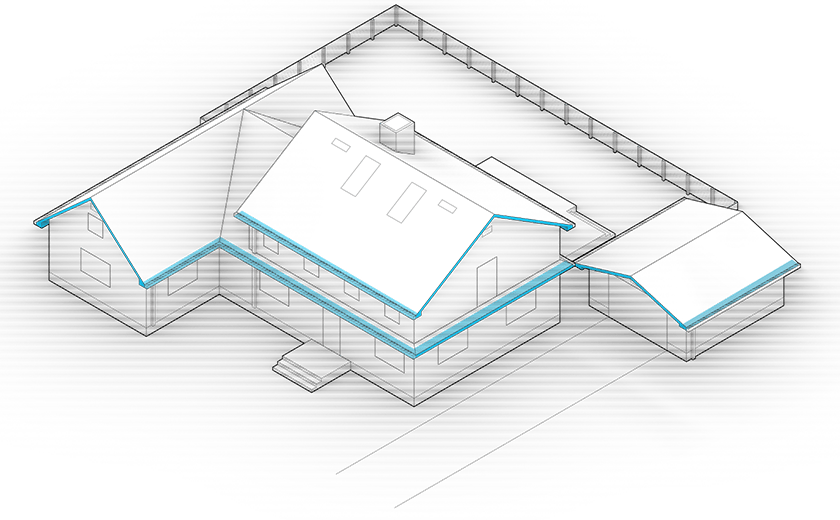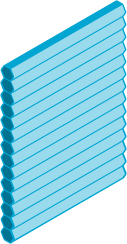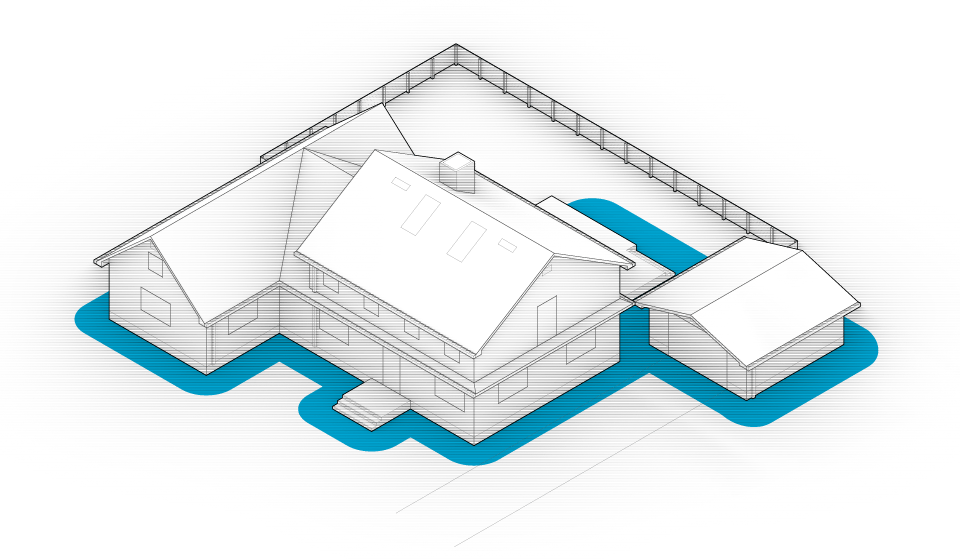
HOUSE (MAINTAIN)
A resilient landscape is fire-wise, water wise and promotes biodiversity by using California native plants. These gardens use sustainable practices, plant selection, and maintenance to reduce the risk of fire in the defensible space zone. Resilient gardens save water, protect us from fire and promote biodiversity.
Roof
The roof is the most vulnerable component of your home! During a wildfire it must be able to resist wind-blown embers and other wildfire exposures. Complex roofs, where the roof meets vertical walls and/or includes dormers, present additional vulnerabilities. Replacing a roof is a major project, but it can yield major benefits. Evaluating the vulnerability of the roof should be a top priority when considering a new home or remodeling an existing property. Proper roof maintenance is critical to reduce the ignition risk of your home!
RELATIVE COST AND PRIORITY LEVEL OF HOME HARDENING FEATURES FOR FIRE-RESISTANCE
 |
 |
 |
 |
 |
 |
|
 |
||||||
 |
 |
 |
 |
|||
 |
||||||
Relative cost: Indicates the relative cost of upgrading the listed features to ember-resistant materials and design.
Priority level: Indicates the features most vulnerable to wildfires and embers. Keep in mind each situation is unique and may change your priority level.

 |
 |
Verify your roof has a Class A rating. |
|
 |
 |
Remove vegetation debris from your roof. |
|
 |
 |
Remove tree limbs that overhang the roof. |
|
 |
 |
Inspect regularly vulnerable areas, especially roof-to-wall intersections. |
|
 |
 |
Check for gaps between roof covering and sheathing. |
|
 |
 |
Cover your chimney and stovepipe outlets with spark arrestor. |
|
 |
 |
Make sure tree branches are at least 10’ away from any chimney outlet. |
|
Resources:
Wildfire Research Fact Sheet – Roofing materials (NFPA, 2017)
P-737 Home Builder’s Guide to Construction in Wildfire Zones (FEMA, 2008)
Ready, Set, Go! Your Personal Wildland Fire Action Guide (FireSafe Sonoma, 2019)
Su Guía de Acción en Caso de Incendio Forestal (FireSafe Sonoma, 2019)
Home Survival in Wildfire-Prone Areas: Building Materials and Design Considerations (UCANR, 2010)
Homeowner’s Wildfire Mitigation Guide – Roof Covering (UCANR, 2019)
Wildfire Home Retrofit Guide (University of Nevada, Reno Extension, 2020)
Preparing Your Home (University of California Cooperative Extension, 2022)
State Fire Marshal Listed Wildland Urban Interface (WUI) Products Handbook (Cal Fire, 2021)
Gutters
Gutters are a often a place for combustible debris to accumulate. Cleaning and maintaining the gutters will reduce ignition risk. Leaf guards and gutters should therefore be checked regularly and debris removed if necessary
RELATIVE COST AND PRIORITY LEVEL OF HOME HARDENING FEATURES FOR FIRE-RESISTANCE
 |
 |
 |
 |
 |
 |
|
 |
||||||
 |
 |
 |
 |
|||
 |
||||||
Relative cost: Indicates the relative cost of upgrading the listed features to ember-resistant materials and design.
Priority level: Indicates the features most vulnerable to wildfires and embers. Keep in mind each situation is unique and may change your priority level.

 |
 |
Remove vegetation debris from your roof |
|
 |
 |
Install non-combustible roof gutters (e.g. metal) | |
 |
 |
Install leaf guards or enclose rain gutters to prevent accumulation of vegetation debris | |
 |
 |
Intense heat from a wildfire can distort gutters, leaf guards, and downspouts. They may need to be replaced after a wildfire | |
 |
 |
Some leaf guards can become dislodged over time, reducing their effectiveness | |
 |
 |
Some types of leaf guards do not prevent all types of debris from accumulating in the gutter (e.g. mesh-type leaf guards allow pine needles to accumulate). Check regularly and remove debris if necessary. |
Sources:
Wildfire Research Fact Sheet – Roofing Materials (NFPA, 2017)
Fact Sheet No. 9 – Gutters and Downspouts (FEMA, 2008)
P-737 Home Builder’s Guide to Construction in Wildfire Zones (FEMA, 2008)
Building and Living in the WUI (VCoFD, 2019)
Home Survival in Wildfire-Prone Areas: Building Materials and Design Considerations (UCANR, 2010)
Eaves, Overhangs, Soffits
Windborne embers, convective heat, and radiant heat can be trapped under overhangs and in the upper portion of exterior walls. It is important to remove combustible items and maintain an ember-resistance zone around the overhangs. Overhangs and walls can ignite if not constructed of noncombustible or fire-resistant materials.
RELATIVE COST AND PRIORITY LEVEL OF HOME HARDENING FEATURES FOR FIRE-RESISTANCE
 |
 |
 |
 |
 |
 |
|
 |
||||||
 |
 |
 |
 |
|||
 |
||||||
Relative cost: Indicates the relative cost of upgrading the listed features to ember-resistant materials and design.
Priority level: Indicates the features most vulnerable to wildfires and embers. Keep in mind each situation is unique and may change your priority level.
Relative cost: Indicates the relative cost of upgrading the listed features to ember-resistant materials and design.
Priority level: Indicated the features most vulnerable to wildfires and embers. Keep in mind each situation is unique and may change your priority level.

 |
 |
Evaluate the fire-resistance of existing soffits and replace soffits that are not fire-resistant | |
 |
 |
Remove debris and combustible material (e.g. plants, patio furniture, vegetation debris, firewood…) from under eaves and overhangs |
Sources:
How To Prepare Your Home for Wildfire (NFPA)
Wildfire Research Fact Sheet – Under-eave construction (NFPA, 2017)
Fact Sheet No. 6 – Eaves, Overhangs, and Soffits (FEMA, 2008)
P-737 Home Builder’s Guide to Construction in Wildfire Zones (FEMA, 2008)
Building and Living in the WUI (VCoFD, 2019)
Home Survival in Wildfire-Prone Areas: Building Materials and Design Considerations (UCANR, 2010)
Vents
Embers and hot gases from nearby vegetation or buildings can be blown or pulled into the openings and enter attic spaces, crawlspaces, ductwork, potentially leading to ignition from the inside of the building. Simple maintenance steps can help reduce vulnerability to wildfires.
RELATIVE COST AND PRIORITY LEVEL OF HOME HARDENING FEATURES FOR FIRE-RESISTANCE
 |
 |
 |
 |
 |
 |
|
 |
||||||
 |
 |
 |
 |
|||
 |
||||||
Relative cost: Indicates the relative cost of upgrading the listed features to ember-resistant materials and design.
Priority level: Indicates the features most vulnerable to wildfires and embers. Keep in mind each situation is unique and may change your priority level.

 |
 |
Install non-corrosive metal mesh screens with a maximum opening of 1/8 inch (3.2 mm) at all vent opening | |
 |
 |
Baffle attic and soffit vents as 1/8 inch metal mesh may not be enough to prevent ember intrusions for those type of vents | |
 |
 |
Remove debris that accumulate near vent openings, screens, and louver blades | |
 |
 |
Remove vegetation near vent openings to prevent ember attacks or ignition by radiant heat | |
 |
 |
Turn off HVAC systems and exhaust fans during wildfire threats to prevent hot gases and embers from being pulled into the buildings |
Sources:
Wildfire Research Fact Sheet – Roofing Materials (NFPA, 2017)
Fact Sheet No. 8 – Vents (FEMA, 2008)
P-737 Home Builder’s Guide to Construction in Wildfire Zones (FEMA, 2008)
Building and Living in the WUI (VCoFD, 2019)
Home Survival in Wildfire-Prone Areas: Building Materials and Design Considerations (UCANR, 2010)Wildland Urban Interface (WUI)”
Windows, Sliding Glass Doors, Skylights
Windows, sliding glass doors, and skylights are key structure components to prevent ignition of the interior of your home because of intrusion of windborne embers, hot gases and radiant heat. You can reduce your ignition risk by following these recommendations for maintenance.
RELATIVE COST AND PRIORITY LEVEL OF HOME HARDENING FEATURES FOR FIRE-RESISTANCE
 |
 |
 |
 |
 |
 |
|
 |
||||||
 |
 |
 |
 |
|||
 |
||||||
Relative cost: Indicates the relative cost of upgrading the listed features to ember-resistant materials and design.
Priority level: Indicates the features most vulnerable to wildfires and embers. Keep in mind each situation is unique and may change your priority level.

 |
 |
Remove doormats. Embers and firebrands can ignite doormats, exposing your doors to high radiant heat and flames | |
 |
 |
Move combustible materials (e.g. patio furniture, plants…) away from your doors and windows | |
 |
 |
Remove vegetation debris that accumulated around skylights | |
 |
 |
Close skylights during wildfire threats, and equipped with screens to resist ember attacks |
Sources:
How To Prepare Your Home for Wildfire (NFPA)
Wildfire Research Fact Sheet – Skylights (NFPA, 2017)
Fact Sheet No. 10 – Windows and Skylights (FEMA, 2008)
P-737 Home Builder’s Guide to Construction in Wildfire Zones (FEMA, 2008)
Building and Living in the WUI (VCoFD, 2019)
Home Survival in Wildfire-Prone Areas: Building Materials and Design Considerations (UCANR, 2010)
Doors
If you cannot afford to replace your doors and windows, it is even more important to carefully manage and maintain the vegetation closest to your home. This includes both vegetation and combustible materials such as firewood and lumber. Avoid storing combustible materials near your home or business. A noncombustible rock-type mulch should be used in the area immediately adjacent to your home or business.
RELATIVE COST AND PRIORITY LEVEL OF HOME HARDENING FEATURES FOR FIRE-RESISTANCE
 |
 |
 |
 |
 |
 |
|
 |
||||||
 |
 |
 |
 |
|||
 |
||||||
Relative cost: Indicates the relative cost of upgrading the listed features to ember-resistant materials and design.
Priority level: Indicates the features most vulnerable to wildfires and embers. Keep in mind each situation is unique and may change your priority level.

 |
 |
Remove doormats. They can be ignited by embers and increase exposure of your door to flames and radiant heat. | |
 |
 |
Remove vegetation or other combustible materials that are within 5 feet of windows and doors. |
Sources:
How To Prepare Your Home for Wildfire (NFPA)
Fact Sheet No. 11: Exterior Doors (FEMA, 2008)
P-737 Home Builder’s Guide to Construction in Wildfire Zones (FEMA, 2008)
Building and Living in the WUI (VCoFD, 2019)
Home Survival in Wildfire-Prone Areas: Building Materials and Design Considerations (UCANR, 2010)
Walls, Sidings, Coatings
Exterior walls are susceptible to wildfire flames, conductive heat, and radiant heat. Flames and heat can ignite combustible wall coverings. When exterior walls ignite, the fire can spread to other components of the building such as the roof, soffit, windows, and doors, resulting in substantial damage to or total loss of the building. Windborne embers and firebrands are also sources of ignition. Embers can become trapped in cracks in walls, window openings, and door trim boards and ignite combustible materials.
RELATIVE COST AND PRIORITY LEVEL OF HOME HARDENING FEATURES FOR FIRE-RESISTANCE
 |
 |
 |
 |
 |
 |
|
 |
||||||
 |
 |
 |
 |
|||
 |
||||||
Relative cost: Indicates the relative cost of upgrading the listed features to ember-resistant materials and design.
Priority level: Indicates the features most vulnerable to wildfires and embers. Keep in mind each situation is unique and may change your priority level.

 |
 |
Maintenance and removal of combustible debris (e.g. vegetation, leaves, firewood) is key to reduce your vulnerability to ignition | |
 |
 |
If you have combustible siding, incorporating an ember-resistant zone (ERZ) next to your home would reduce the vulnerability of your siding | |
 |
 |
If you have a chinked-style log home, inspect the chinking for cracks and missing pieces. Repair and replace with fire-rated chinking. |
Sources:
How To Prepare Your Home for Wildfire (NFPA)
Wildfire Research Fact Sheet – Coatings (NFPA, 2017)
Fact Sheet No. 7: Exterior Walls (FEMA, 2008)
P-737 Home Builder’s Guide to Construction in Wildfire Zones (FEMA, 2008)
Building and Living in the WUI (VCoFD, 2019)
Home Survival in Wildfire-Prone Areas: Building Materials and Design Considerations (UCANR, 2010)
Fences
Landscape fencing and walls that are attached to or near buildings in wildfire zones can represent a high ignition risk by spreading flames or radiant heat from one building to another. Follow the guidelines presented here to reduce potential damage.
RELATIVE COST AND PRIORITY LEVEL OF HOME HARDENING FEATURES FOR FIRE-RESISTANCE
 |
 |
 |
 |
 |
 |
|
 |
||||||
 |
 |
 |
 |
|||
 |
||||||
Relative cost: Indicates the relative cost of upgrading the listed features to ember-resistant materials and design.
Priority level: Indicates the features most vulnerable to wildfires and embers. Keep in mind each situation is unique and may change your priority level.

 |
 |
Maintain the physical condition of your fence or wall | |
 |
 |
Clear and remove combustible debris near the fence or wall | |
 |
 |
Do not store firewood against the fence | |
 |
 |
Regularly maintain the landscape vegetation planted next to your fence. Unmanaged vegetation increases the probability that the fence will ignite | |
 |
 |
Avoid combustible mulch and vegetation within at least 2’ of combustible fencing. |
Sources:
How To Prepare Your Home for Wildfire (NFPA)
Wildfire Research Fact Sheet – Fencing (NFPA, 2017)
Fact Sheet No. 14 – Landscape Fences and Walls (FEMA, 2008)
P-737 Home Builder’s Guide to Construction in Wildfire Zones (FEMA, 2008)
Building and Living in the WUI (VCoFD, 2019)
Home Survival in Wildfire-Prone Areas: Building Materials and Design Considerations (UCANR, 2010)
Decks
To minimize the possibility of deck ignitions, reduce fuels in the home ignition zones by carefully selecting and positioning vegetation and implementing regular maintenance.
RELATIVE COST AND PRIORITY LEVEL OF HOME HARDENING FEATURES FOR FIRE-RESISTANCE
 |
 |
 |
 |
 |
 |
|
 |
||||||
 |
 |
 |
 |
|||
 |
||||||
Relative cost: Indicates the relative cost of upgrading the listed features to ember-resistant materials and design.
Priority level: Indicates the features most vulnerable to wildfires and embers. Keep in mind each situation is unique and may change your priority level.

 |
 |
Do not store combustible material beneath the deck | |
 |
 |
Routinely remove debris that accumulates in-between deck board gaps and at the intersection between the deck and the house | |
 |
 |
Remove combustible items (e.g.cushions, brooms and door mats inside). Also move smaller furniture inside, particularly wicker furniture, which could be more easily ignited by embers |
Sources:
How To Prepare Your Home for Wildfire (NFPA)
Wildfire Research Fact Sheet – Decks (NFPA, 2017)
Wildfire Research Fact Sheet – Fire spread on ember-ignited decks (NFPA, 2017)
Fact Sheet No. 13 – Decks and Other Attached Structures (FEMA, 2008)
P-737 Home Builder’s Guide to Construction in Wildfire Zones (FEMA, 2008)
Building and Living in the WUI (VCoFD, 2019)
Home Survival in Wildfire-Prone Areas: Building Materials and Design Considerations (UCANR, 2010)
Defensible Systems
Defensive actions can potentially help your home survive a wildfire. These actions are in addition to creating and maintaining defensible space on your property and selection of appropriate building materials listed on this website.
RELATIVE COST AND PRIORITY LEVEL OF HOME HARDENING FEATURES FOR FIRE-RESISTANCE
 |
 |
 |
 |
 |
 |
|
 |
||||||
 |
 |
 |
 |
|||
 |
||||||
Relative cost: Indicates the relative cost of upgrading the listed features to ember-resistant materials and design.
Priority level: Indicates the features most vulnerable to wildfires and embers. Keep in mind each situation is unique and may change your priority level.

 Exterior Water Spray Systems
Exterior Water Spray Systems
An exterior water spray system can be roof- or ground-mounted. The objective of the sprinklers is to limit the spread of the fire to the home and/or extinguish wind-blown embers before they reach the building being protected. It is important to understand that the effectiveness of an external sprinkler system has not been completely evaluated.
If you are considering an external sprinkler system, check with your local fire department. They may have plans, and other suggestions. In order to maximize the effectiveness of exterior sprinklers, they should be on a stand-alone, independent water system (i.e., tank, pool or lake) and should be attached to a pressurized delivery system or use a generator for needed pumps.
 Gel Coating
Gel Coating
Gels are water absorbent polymers that can be applied to a building component to provide temporary protection from radiant heat or flames. You may have heard of these products being applied to homes when a wildfire is threatening. Once applied, the absorbed water starts to evaporate, whether or not the wildfire actually arrives, and therefore the time that a gel coating is effective is limited. The effective time is on the order of hours. It is not warranted to rely on a coating in lieu of managing vegetation or improving building materials and design.
Given the potential issues regarding performance, it is recommended that the use of defensive actions be a supplement to, and not a replacement for, already proven mitigation strategies, such as the reduction of potential fuels throughout the home ignition zones, along with removal of roof and gutter debris, and use of noncombustible and fire/ember-ignition resistant building materials and installation design details.
Sources:
How To Prepare Your Home for Wildfire (NFPA)
Wildfire Research Fact Sheet – Exterior Sprinklers Systems (NFPA, 2017)
Wildfire Research Fact Sheet – Fire spread on ember-ignited decks (NFPA, 2017)
Fact Sheet No. 15 – Fire Sprinklers (FEMA, 2008)
Fact Sheet No. 16 – Utilities and Exterior Equipment (FEMA, 2008)
P-737 Home Builder’s Guide to Construction in Wildfire Zones (FEMA, 2008)
Building and Living in the WUI (VCoFD, 2019)
Home Survival in Wildfire-Prone Areas: Building Materials and Design Considerations (UCANR, 2010)
CAL FIRE provides a list of Wildland Urban Interface (WUI) Approved Products.
Visit their website and search for “8120 – Exterior Windows for Wildland Urban Interface (WUI)”